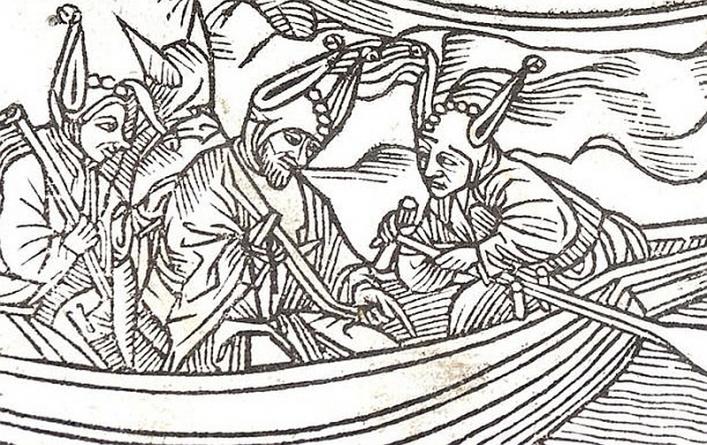The Ship of Fools

This important book was published in 1494 in Basel.
The Ship of Fools, or Stultifera navis, was a common medieval allegory for both humanity's voyage on the seas of time, and more specifically for the 'ark of salvation'—the Church—the Latin word navis signifying both a boat and the nave of a church.
Das Narrenschiff, or Ship of Fools, is a satire in the form of a poem, published in 1494 in Basel, Switzerland, by Sebastian Brant, a conservative German theologian. It consists of 114 brief sketches, each illustrated by a woodcut, many of which are thought to have been designed by a young Albrecht Dürer, who stayed in Basel for a short time in 1494. Around this time Hieronymus Bosch created a triptych (most of which is lost), one wing of which featured the same motif. The painting, which is thought to have been inspired by this book, is in the Louvre Museum in Paris.
In the book, Brant is exhorting the German people to assert their superiority by adopting more moral behaviour. Although he did not support the Reformation, many of the criticisms implied in his work were later echoed by that movement.
The book became very popular and was swiftly translated into Latin and other languages. The Priaulx Library holds a folio edition from 1570, which was printed in London by Thomas Cawood, having been translated from the Latin edition of 1497 by Alexander Barclay. This is the first English edition and includes additional poetry in translation. The text is in Gothic type; the binding dates from the 19th century. The book is part of Osmond de Beauvoir Priaulx's original bequest to the people of Guernsey.
A complete set of the woodcuts from the 1497 Latin edition of the book have been beautifully digitised by Special Collections, University of Houston Libraries, and can be viewed here.
It is instructive to compare the images from the English edition held in the Priaulx Library with the original images from the Latin edition of 1497. It is very evident that the publisher commissioned a set of copies of the illustrations, which, although pleasing, are crude in comparison. In the example below, Dürer's graceful and naturalistic tree on the left has been transformed and is virtually unrecognisable; the church has disappeared altogether (compare).
Of the vayne care of Astronomie
'Here call we to our foolish company,
Such fools as labour and study with great payne,
To judge the planetes by their Astronomy,
And other crafts without profite, and vayne:
Come hither Astronomers, have ye no disdayne
Ye planetistes and witches, and other of this sort,
Which honour the starres only as your comfort.'
Of disordered love and Venerious (compare to Dürer's original 'Of Wooing')


